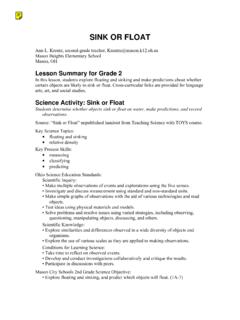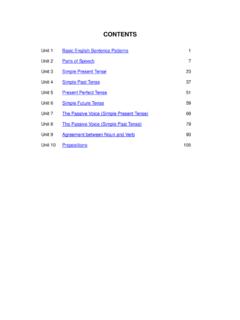Transcription of Bloodstain Pattern Simulations: A Physical Analysis
1 To close the yellow note, click once to select it and then click the box in the upper left corner. To open the note, double click (Mac OS) or right click (Windows) on the note icon. Bloodstain Pattern Simulations: A Physical Analysis Tim Morrison, Parkway South High School, Manchester, MO. INTRODUCTION. Description Following graphical and vector Analysis , this lab exercise is an open-ended or discovery activity. Students receive Bloodstain Pattern evidence from a crime scene. They must then answer a series of questions through inquiry, observation, measurement, and Analysis . To complete this challenge, students reconstruct the evidence through four standard models to derive qualitative characteristics and quantitative relationships that address the evidence at the crime scene.
2 In addition, students will utilize the following impact equation and the concept of free fall in which an object falls from rest. impact = mass velocity free fall velocity from resting position = (gravitational acceleration) (time). Student Audience This activity is designed for secondary students learning about the applications of physics. Goals for the Activity The main goals of this activity are for students to construct evidence similar to that found at a crime scene and derive specific characteristics and mathematical relationships from standard models;. follow procedures for measurement, organization, and Analysis of evidence from a hypothetical crime scene and draw conclusions using a database of standards.
3 Emphasize and enhance the skills of observation;. consider and develop an appreciation for the complexity of evidence that may occur at an actual crime scene; and understand the interrelationships of vectors, impact, and free fall. Recommended Placement in the Curriculum This activity should be conducted in an introductory or applied physics course as a practical application unit utilizing vector and graphical Analysis in forensic science. Developed through the National Science Foundation-funded Partnership for the Advancement of Chemical Technology (PACT) 1. Collection of Laboratory Activities: Bloodstain Pattern Simulations: A Physical Analysis STUDENT HANDOUT. Bloodstain Pattern Simulations: A Physical Analysis Purpose Determine the following characteristics pertaining to Bloodstain patterns at a crime scene: a.
4 The height from which a droplet fell, b. the travel direction of a drop colliding with a stationary surface, c. the angle of impact of blood on a smooth surface, and d. the origin of blood spatter in two dimensions on a smooth surface. Materials Part A. Per group eyedropper ring stand and clamp meterstick or metric tape white paper stock (Recycle if possible.). newsprint (optional, may add a factor of difficulty in measurements). calipers V-8 vegetable juice or tomato-soup concentrate (Do not dilute. One can of soup is enough for a class.). Part B. Per group small container of approximately 100 mL of juice or concentrate white paper stock or newsprint toothbrush Part C.
5 Per group ring stand and clamp eyedropper meterstick or metric tape protractor 5, 10-cm-wide cardboard strips cut from cereal boxes (The length of the strip equals the height of the box.). calipers Part D. same as for Part B. Part A: Height from Which a Droplet Fell Procedure 1. Mount an eyedropper perpendicular to the floor or countertop with a ring stand and clamp. 2. Place paper that is identical to that from the crime scene over the floor or countertop at the base of the ring stand. Developed through the National Science Foundation-funded Partnership for the Advancement of Chemical Technology (PACT) 2. Collection of Laboratory Activities: Bloodstain Pattern Simulations: A Physical Analysis 3.
6 Fill the dropper with vegetable juice or tomato-soup concentrate. 4. Adjust the dropper so that the tip is 15 cm from the surface of the paper. 5. Squeeze out a single drop to splatter on the paper below. Slide the paper over and squeeze another drop. Repeat for a total of five drops. 6. Allow the drops to dry. Record significant observations about the drops. It may help to illuminate the paper from behind to highlight the droplets. Using calipers, measure the diameter of each red stain and record. 7. Repeat steps 4 through 6, each time raising the dropper tip an additional 15 cm until a 135-cm vertical distance is reached. 8. Record your observations and measurements in Table 1.
7 9. Calculate the average diameter of the drops from each height. Record your calculations and observations in Table 2. Table 1. Height (cm) Diameter (mm). Trial 1 Trial 2 Trial 3 Trial 4 Trial 5 Average 15. 30. 45. 60. 75. 90. 105. 120. 135. Developed through the National Science Foundation-funded Partnership for the Advancement of Chemical Technology (PACT) 3. Collection of Laboratory Activities: Bloodstain Pattern Simulations: A Physical Analysis Table 2. Average Height (cm) Characteristic Observations Diameter (mm). 15. 30. 45. 60. 75. 90. 105. 120. 135. crime scene Questions 1. Describe the relationship between the distance of fall and the diameter of the droplet.
8 2. What characteristic observations did you make concerning your standard? 3. What was the extrapolated distance of fall at the crime scene? 4. What possible sources of error could have occurred during the procedure? 5. What adaptations did you make or would you suggest in performing this activity? 6. How do the following equations relate to your data? Design a brief mathematical example to illustrate this relationship. impact = mass velocity free fall velocity from resting position = (gravitational acceleration) (time). Part B: Direction of Travel of Blood Procedure 1. Lay paper that is identical to the crime scene paper smoothly on the floor. 2. Dip a toothbrush into a small container of juice or concentrate.
9 3. Grip the toothbrush in your hand so that when your arm hangs freely at your side, the bristles of the brush point vertically up toward the ceiling. Developed through the National Science Foundation-funded Partnership for the Advancement of Chemical Technology (PACT) 4. Collection of Laboratory Activities: Bloodstain Pattern Simulations: A Physical Analysis 4. Standing on the paper, quickly flip your forearm up to form a right angle with your upper arm. At this point, a nice blood spatter should have formed on the paper. This step may be repeated for better results. Allow the spatter to dry, and analyze it. 5. Save the results for Part D. Data Describe the spatter. Questions 1.
10 What observation can you make concerning the droplets' direction of travel? 2. Which direction did the droplets travel in the crime scene? Be specific. 3. Explain the droplet shape in terms of friction. Part C: Angle of Impact Procedure 1. Arrange an inclined plane with the brown cardboard side of a cereal box up and the printed side down facing the countertop. An additional ring stand may be used for support. 2. Mount an eyedropper perpendicular to the countertop with a ring stand and clamp. 3. As the cardboard stands on end perpendicular to the countertop, the angle of impact (or angle to the dropper) is 0 and the angle with the countertop is 90 . Using a protractor or trigonometric measurements, adjust the cardboard incline to an impact angle of 15 with respect to the dropper.







